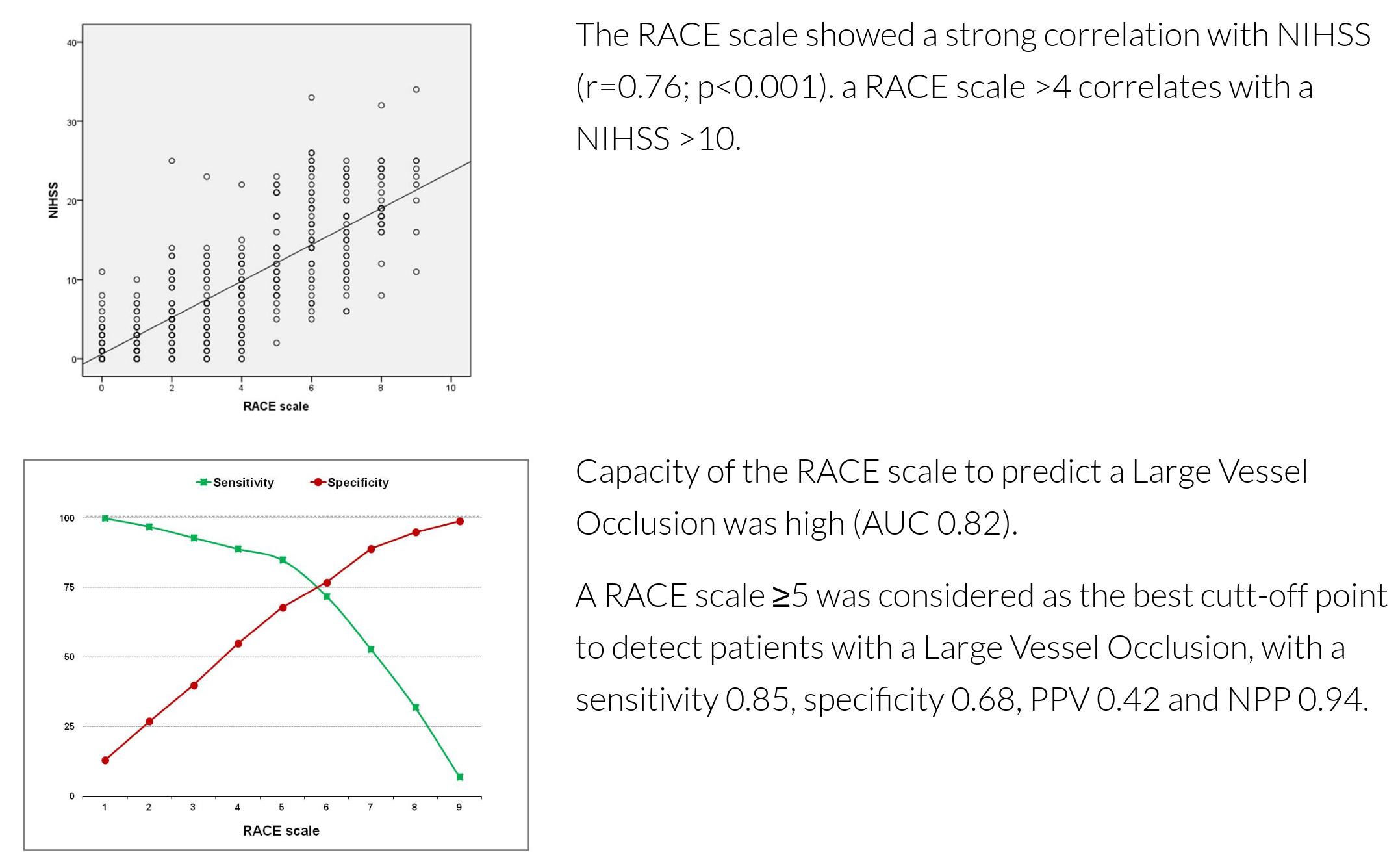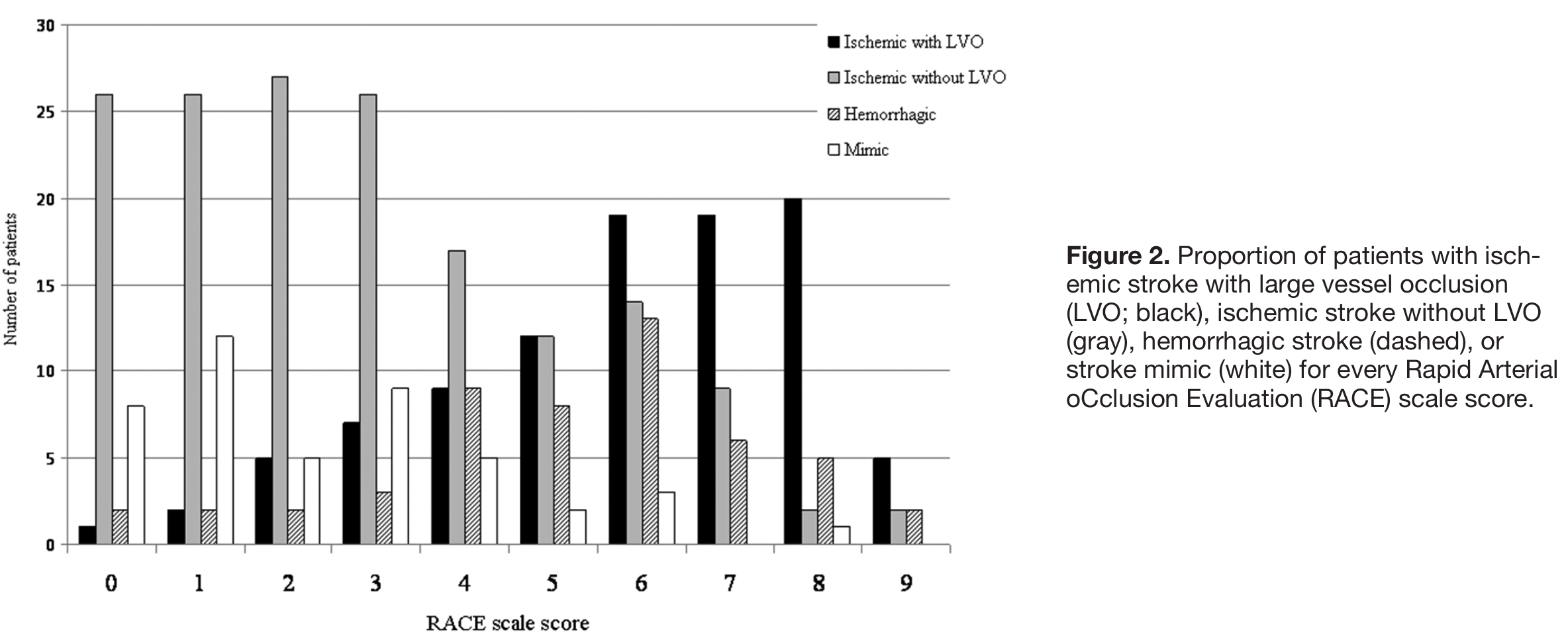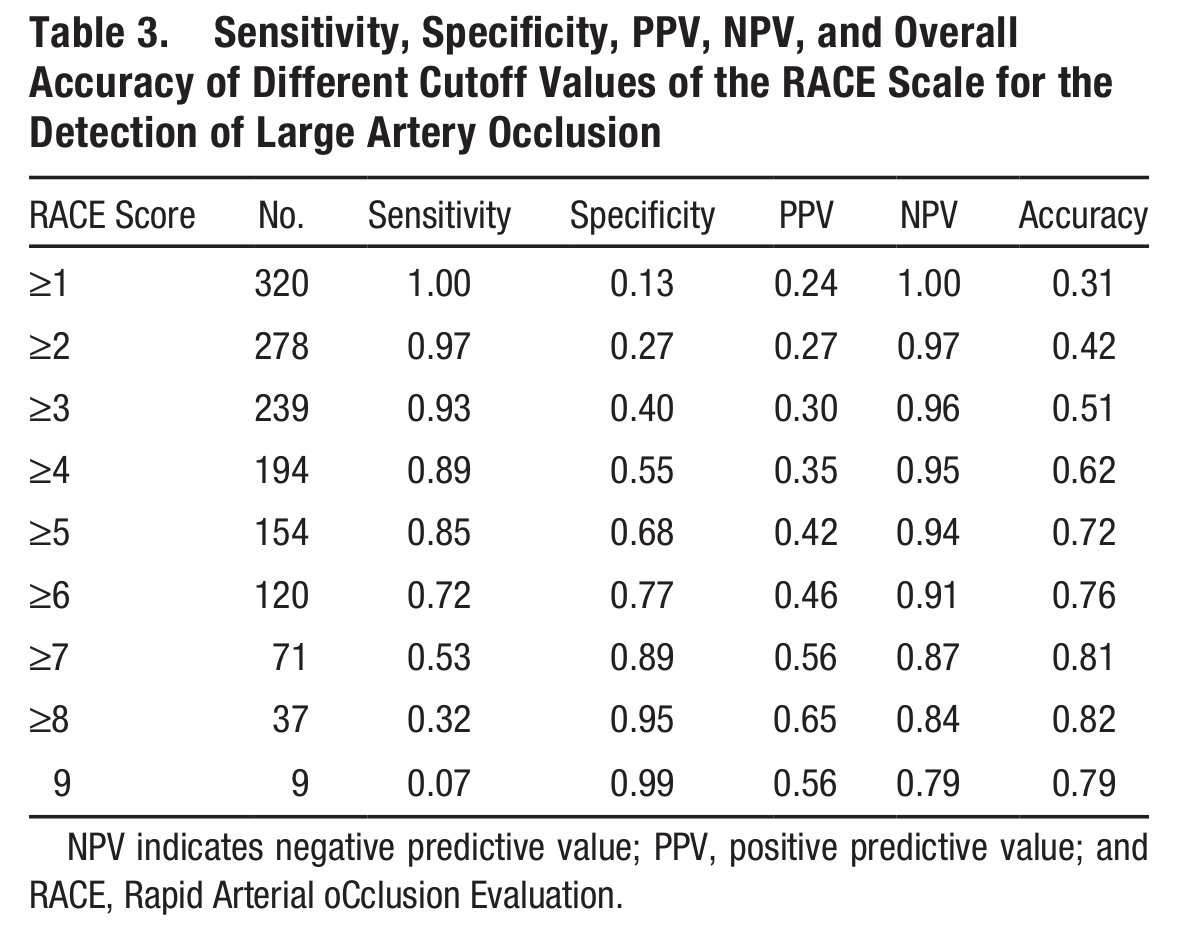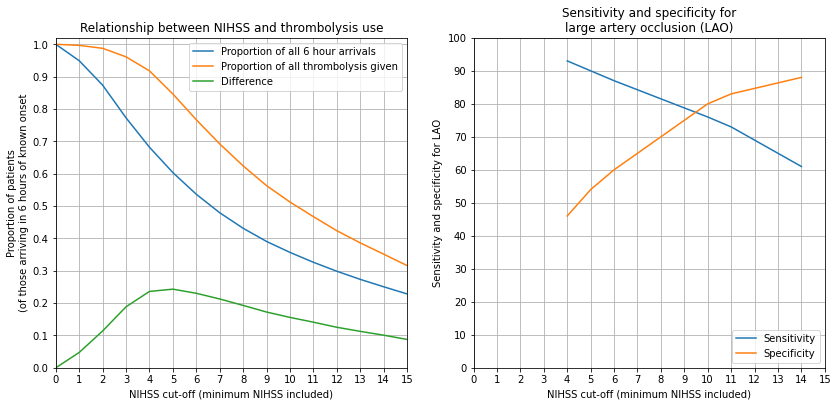Using NIHSS to select large artey occulsion stroke patients (most suitable for thrombectomy)
Contents
Using NIHSS to select large artey occulsion stroke patients (most suitable for thrombectomy)#
Clinical assessment of stroke has been proposed as a method of selecting patients for transfer directly to comprehensive stroke centres which provide both thrombectomy and thrombolysis. Use of NIHSS has been shown to have the best performance of all clinical tests for prediction of large arety occlusion [1], though NIHSS is not easily or quickly performed pre-hospital, so simpler tests have been proposed, with RACE having the best performance [1], and being based on, and having been shown to be well correlated with, NIHSS [2,3].
In this experiement we look at how NIHSS predicts use of of thrombolysis, alongside publsihed results for NIHSS predicting the presence of large artery occlusion [4].
[1] Duvekot MHC, Venema E, Rozeman AD, et al. Comparison of eight prehospital stroke scales to detect intracranial large-vessel occlusion in suspected stroke (PRESTO): a prospective observational study. The Lancet Neurology 2021;20:213–21. doi:10.1016/S1474-4422(20)30439-7
[2] de la Ossa Herrero N, Carrera D, Gorchs M, et al. Design and Validation of a Prehospital Stroke Scale to Predict Large Arterial Occlusion The Rapid Arterial Occlusion Evaluation Scale. Stroke; a journal of cerebral circulation 2013;45. doi:10.1161/STROKEAHA.113.003071
[3] http://racescale.org/2015/08/03/scale-validation/
[4] Turc G, Maïer B, Naggara O, et al. Clinical Scales Do Not Reliably Identify Acute Ischemic Stroke Patients With Large-Artery Occlusion. Stroke 2016;47:1466–72. doi:10.1161/STROKEAHA.116.013144
# import libraries
import matplotlib.pyplot as plt
import numpy as np
import pandas as pd
# import data
raw_data = pd.read_csv(
'./../data/2019-11-04-HQIP303-Exeter_MA.csv', low_memory=False)
Restrict original data to hospitals with at least 300 admissions + 10 thrombolysis patients#
keep = []
groups = raw_data.groupby('StrokeTeam') # creates a new object of groups of data
for index, group_df in groups: # each group has an index and a dataframe of data
# Skip if total admissions less than 300 or total thrombolysis < 10
admissions = group_df.shape[0]
thrombolysis_received = group_df['S2Thrombolysis'] == 'Yes'
if (admissions < 300) or (thrombolysis_received.sum() < 10):
continue
else:
keep.append(group_df)
# Concatenate output
data = pd.DataFrame()
data = pd.concat(keep)
print (data.shape)
(239505, 62)
Restrict to known NIHSS#
# Restrict data to determined NIHSS
mask = data['S2NihssArrival'] >= 0
data = data[mask]
Restrict to known onset within 6 hours#
mask = (data['S1OnsetToArrival_min'] <= 360) & (data['S1OnsetToArrival_min'] >= 0)
print (f'Proportion with known onset of up to 6 hours: {mask.mean():0.3f}')
data = data[mask]
Proportion with known onset of up to 6 hours: 0.434
Iterate through NIHSS cutoff#
results = []
for nihss in range(0, 16):
mask = data['S2NihssArrival'] >= nihss
selected_data = data[mask]
row_results = dict()
row_results['Min NIHSS'] = nihss
row_results['Proportion'] = selected_data.shape[0] / data.shape[0]
row_results['Arrive in 4 hours'] = np.mean(selected_data['S1OnsetToArrival_min'] <= 240)
row_results['Infarction'] = np.mean(selected_data['S2StrokeType'] == 'Infarction')
row_results['Haemorrhage'] = np.mean(selected_data['S2StrokeType'] == 'Primary Intracerebral Haemorrhage')
row_results['Thrombolysis'] = np.mean(selected_data['S2Thrombolysis'] == 'Yes')
row_results['Prop of all thrombolysis'] = (
np.sum(selected_data['S2Thrombolysis'] == 'Yes') / np.sum(data['S2Thrombolysis'] == 'Yes'))
results.append(row_results)
results = pd.DataFrame(results)
results
| Min NIHSS | Proportion | Arrive in 4 hours | Infarction | Haemorrhage | Thrombolysis | Prop of all thrombolysis | |
|---|---|---|---|---|---|---|---|
| 0 | 0 | 1.000000 | 0.865353 | 0.863379 | 0.135339 | 0.263754 | 1.000000 |
| 1 | 1 | 0.949110 | 0.867161 | 0.861880 | 0.136977 | 0.276948 | 0.996591 |
| 2 | 2 | 0.873663 | 0.871033 | 0.856163 | 0.142784 | 0.298120 | 0.987500 |
| 3 | 3 | 0.772523 | 0.877520 | 0.846576 | 0.152381 | 0.328134 | 0.961089 |
| 4 | 4 | 0.681749 | 0.884194 | 0.836926 | 0.162104 | 0.355088 | 0.917829 |
| 5 | 5 | 0.603316 | 0.890638 | 0.827512 | 0.171495 | 0.370004 | 0.846356 |
| 6 | 6 | 0.536375 | 0.896123 | 0.817681 | 0.181298 | 0.376989 | 0.766654 |
| 7 | 7 | 0.479221 | 0.901052 | 0.808963 | 0.189980 | 0.380866 | 0.692006 |
| 8 | 8 | 0.431297 | 0.904100 | 0.800268 | 0.198629 | 0.381683 | 0.624138 |
| 9 | 9 | 0.390545 | 0.906716 | 0.792871 | 0.205938 | 0.380174 | 0.562931 |
| 10 | 10 | 0.356698 | 0.908933 | 0.786602 | 0.212123 | 0.378930 | 0.512461 |
| 11 | 11 | 0.326188 | 0.910237 | 0.780710 | 0.217896 | 0.377776 | 0.467202 |
| 12 | 12 | 0.298500 | 0.911917 | 0.775500 | 0.223115 | 0.374420 | 0.423746 |
| 13 | 13 | 0.273355 | 0.913683 | 0.770766 | 0.227835 | 0.372490 | 0.386050 |
| 14 | 14 | 0.250452 | 0.914703 | 0.765939 | 0.232575 | 0.369950 | 0.351293 |
| 15 | 15 | 0.228345 | 0.915000 | 0.760478 | 0.237938 | 0.365076 | 0.316066 |
Appendix - performance of RACE#
The detailed performance of RACE test is described at http://racescale.org/2015/08/03/scale-validation/



Analysis of patient counts#
Note: Quotes sensiyivity and specificity in paper exclude some of these patients from the analysis of sensitivity and specifict presented above (n=320 vs n=357 here).
Patient counts by RACE Score:
RACE |
LVO |
nLVO |
Haemorrhagic |
Mimic |
|---|---|---|---|---|
0 |
1 |
26 |
2 |
8 |
1 |
2 |
26 |
2 |
12 |
2 |
5 |
27 |
2 |
5 |
3 |
7 |
26 |
3 |
9 |
4 |
9 |
17 |
9 |
5 |
5 |
12 |
12 |
8 |
2 |
6 |
19 |
14 |
13 |
3 |
7 |
19 |
9 |
6 |
0 |
8 |
20 |
2 |
5 |
1 |
9 |
5 |
2 |
2 |
0 |
Patient counts by cutoff.
RACE |
LVO |
nLVO |
Haemorrhagic |
Mimic |
Sens |
Spec |
|---|---|---|---|---|---|---|
>= 0 |
99 |
161 |
52 |
45 |
1.000 |
0.000 |
>= 1 |
98 |
135 |
50 |
37 |
0.990 |
0.102 |
>= 2 |
96 |
109 |
48 |
25 |
0.970 |
0.245 |
>= 3 |
91 |
82 |
46 |
20 |
0.919 |
0.317 |
>= 4 |
84 |
56 |
43 |
11 |
0.848 |
0.440 |
>= 5 |
75 |
39 |
34 |
6 |
0.758 |
0.584 |
>= 6 |
63 |
27 |
26 |
4 |
0.636 |
0.687 |
>= 7 |
44 |
13 |
13 |
1 |
0.444 |
0.853 |
>= 8 |
25 |
4 |
7 |
1 |
0.253 |
0.916 |
>= 9 |
5 |
2 |
2 |
0 |
0.051 |
0.979 |
Patient counts by cutoff (excluding mimics)
RACE |
LVO |
nLVO |
Haemorrhagic |
Sens |
Spec |
|---|---|---|---|---|---|
>= 0 |
99 |
161 |
52 |
1.000 |
0.000 |
>= 1 |
98 |
135 |
50 |
0.990 |
0.038 |
>= 2 |
96 |
109 |
48 |
0.970 |
0.076 |
>= 3 |
91 |
82 |
46 |
0.919 |
0.115 |
>= 4 |
84 |
56 |
43 |
0.848 |
0.173 |
>= 5 |
75 |
39 |
34 |
0.758 |
0.344 |
>= 6 |
63 |
27 |
26 |
0.636 |
0.497 |
>= 7 |
44 |
13 |
13 |
0.444 |
0.746 |
>= 8 |
25 |
4 |
7 |
0.253 |
0.863 |
>= 9 |
5 |
2 |
2 |
0.051 |
0.961 |
Converting RACE performance results to NIHSS#
From RACECAT published results, NIHSS = 2.34 RACE.
# Set up figure
fig = plt.figure(figsize=(12,6))
ax1 = fig.add_subplot(121)
x = results['Min NIHSS']
y1 = results['Proportion']
y2 = results['Prop of all thrombolysis']
y3 = y2 - y1
ax1.plot(x, y1, label = 'Proportion of all 6 hour arrivals')
ax1.plot(x, y2, label = 'Proportion of all thrombolysis given')
ax1.plot(x, y3, label = 'Difference')
ax1.set_xlabel('NIHSS cut-off (minimum NIHSS included)')
ax1.set_ylabel('Proportion of patients\n(of those arriving in 6 hours of known onset')
ax1.set_ylim(0, 1.02)
ax1.set_xlim(0, 15)
ax1.set_xticks(np.arange(0, 16))
ax1.set_yticks(np.arange(0, 1.01, 0.1))
ax1.legend()
ax1.grid()
ax1.set_title('Relationship between NIHSS and thrombolysis use')
# LAO performance
ax2 = fig.add_subplot(122)
x = [4,5,6,10,11,14]
sensitivity = [93, 90, 87, 76, 73, 61]
specificity = [46, 54, 60, 80, 83, 88]
ax2.plot(x, sensitivity, label = 'Sensitivity')
ax2.plot(x, specificity, label = 'Specificity')
ax2.set_xlabel('NIHSS cut-off (minimum NIHSS included)')
ax2.set_ylabel('Sensitivity and specificity for LAO')
ax2.set_xticks(np.arange(0, 16))
ax2.set_yticks(np.arange(0, 101, 10))
ax2.legend(loc='lower right')
ax2.grid()
ax2.set_title('Sensitivity and specificity for\nlarge artery occlusion (LAO)')
plt.tight_layout(pad=2)
plt.savefig('output/nihss_cutoff.jpg', dpi=300)
plt.show()
